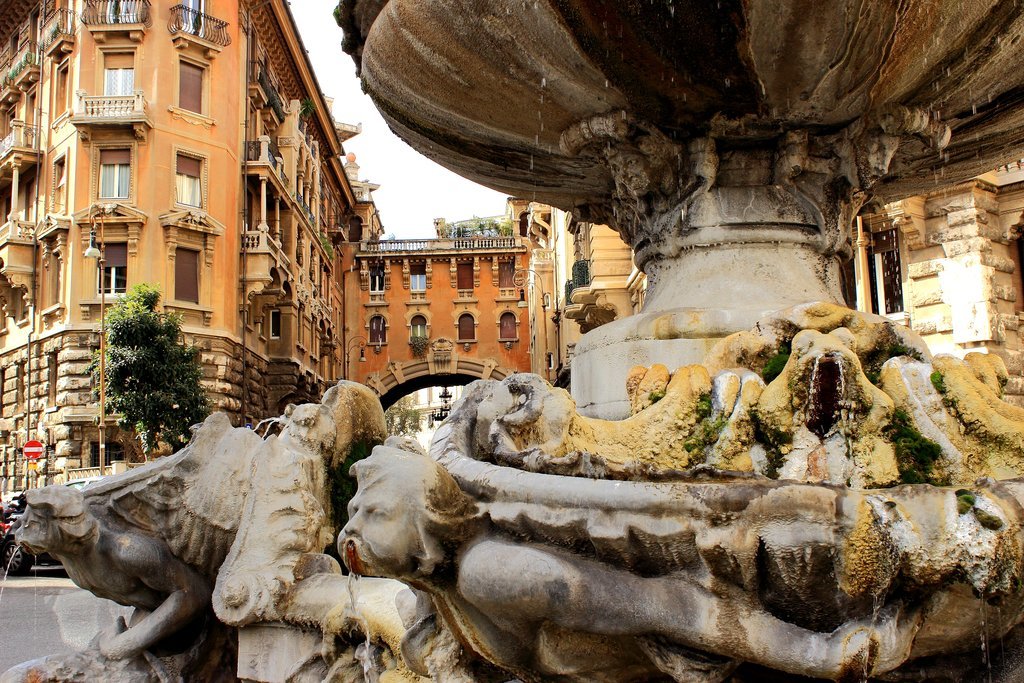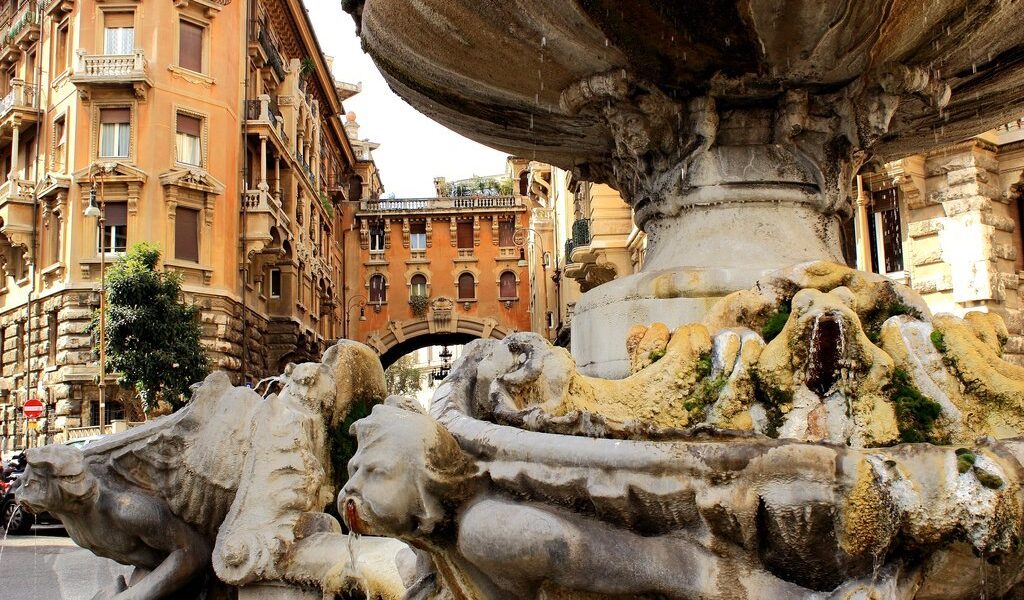
There’s more to Rome than standing in line at the Colosseum and jostling up to the Spanish Steps. With a little insider knowledge (and a pair of decent walking shoes), you can see a totally different side of the Italian capital. See an Egyptian-inspired pyramid, take in the views from hidden hilltop gardens, and stroll through blissfully uncrowded neighborhoods brimming with markets and cafés.
## Rome: Unveiling Hidden Gems Beyond the Tourist Trail
Venture just beyond the well-trodden paths, a mere handful of streets away from the iconic landmarks, and you’ll discover a Rome that whispers secrets to those willing to listen. It’s a Rome of secluded piazzas, their edges lined with charming cafes, a Rome where you can stumble upon a cutting-edge gallery space ingeniously housed within a repurposed power station, or a family-run Jewish patisserie, its aroma of freshly baked goods spilling out onto the cobblestone street. Prepare to delve into the authentic heart of the city with these seven unconventional experiences, each designed to peel back the layers and reveal the true soul of Rome. Forget the queues and the crowds; this is your invitation to truly immerse yourself in the Roman spirit.
## Piramide Cestia: An Ancient Echo of Egypt in Rome
A pyramid? In the heart of Rome? It might seem like an illusion, but it’s undeniably real. The Piramide Cestia stands as one of the Italian capital’s most unexpected and intriguing monuments. Its very existence is a testament to the enduring allure of Ancient Egypt, whose architectural marvels captivated Roman society in the first century BCE. This imposing structure was not conceived as a pharaoh’s tomb, but rather as the final resting place for Gaius Cestius, a Roman nobleman and magistrate who clearly possessed a flair for the dramatic.
To fully appreciate the history and significance of the Piramide Cestia, consider joining one of the hour-long guided tours, currently offered in Italian, which take place on the third and fourth Saturday and Sunday of each month. These tours provide invaluable insights into the pyramid’s construction, its historical context, and the life of the man it was built to honor.
Alternatively, for a more contemplative experience, escape the hustle and bustle and find solace in the serene atmosphere of the adjacent Protestant Cemetery. Here, amidst the verdant landscape and the weathered tombstones, lie the remains of Romantic literary giants John Keats and Percy Shelley. The cemetery offers a tranquil vantage point from which to admire the Piramide Cestia, a unique juxtaposition of ancient Egyptian-inspired architecture and the somber beauty of a final resting place for poets who found inspiration in the Eternal City. The Protestant Cemetery provides not only a space for quiet reflection but also allows for an appreciation of the brick-and-marble monolith in a peaceful setting.
## Monte Pincio: A Panoramic Vista of Roman Splendor
If you seek a breathtaking introduction to the grandeur of Rome, look no further than the panoramic views from Monte Pincio. Perched atop this verdant hill, you’ll be treated to an unrivaled vista of the city sprawling beneath you, a captivating tapestry of terracotta rooftops, ancient monuments, bustling piazzas, and magnificent churches. From this elevated vantage point, you can easily pick out iconic landmarks such as the copper dome of St Peter’s Basilica, a symbol of the Vatican’s power and influence, and the elegant outline of Piazza del Popolo, a gateway to the heart of Rome.
The entire city unfolds before you like a perfectly composed postcard, offering countless opportunities to capture stunning photographs, particularly during the golden hour of sunset when the Roman skyline is bathed in a warm, ethereal glow.
Reaching the sculpture-adorned gardens and the expansive terrace of Monte Pincio is a rewarding experience in itself. You can ascend the hill from either Piazza del Popolo or the famed Spanish Steps, gradually leaving the majority of the crowds behind as you ascend into this tranquil oasis. The classical-style gardens were meticulously designed in the early 19th century by the talented Italian urban planner Giuseppe Valadier, commissioned under the orders of Napoleon. As you meander through the shaded pathways beneath the umbrella pines, keep an eye out for the obelisk that Emperor Hadrian dedicated to commemorate his beloved Greek companion, Antinoüs, a poignant reminder of the enduring power of love and remembrance. Exploring Monte Pincio is a journey through history and beauty, culminating in a view that will forever be etched in your memory.
## Centrale Montemartini: Where Art and Industry Collide
Venture off the beaten path and discover the Centrale Montemartini, a museum that defies expectations by showcasing a remarkable collection of classical art and sculpture within the framework of Rome’s first electrical power station, which commenced operations in 1912. This unique juxtaposition of ancient artistry and industrial architecture creates a visually arresting and thought-provoking experience.
The cavernous interior of the revamped power station provides a striking backdrop for the meticulously curated exhibits. In the former boiler and engine rooms, amidst the hulking machinery and imposing furnaces that remain intact, you’ll find exquisite Greek and Roman marble statues, intricately carved sarcophagi, and stunning mosaics that depict scenes of nautical adventures and exhilarating hunts.
The exhibition unfolds across multiple rooms, each offering a fresh perspective on the interplay between art and industry. Highlights include original Greek and Roman marble statues and busts, elaborately carved sarcophagi and intricate mosaics depicting nautical and hunting scenes. Unlike many of the more popular museums in the city, Centrale Montemartini is rarely overcrowded, allowing you to fully appreciate the artistry and the unique setting in peace and tranquility.
## Testaccio: An Authentic Slice of Roman Life
For a truly authentic encounter with the Roman way of life, make your way to the centrally located yet delightfully under-visited neighborhood of Testaccio (conveniently accessible via the Piramide metro stop). This is where Romans themselves come to relax and socialize, frequenting the bustling markets, the traditional restaurants, and the inviting cafes during the day, and then gathering in the lively bars as the sun sets. Once the heart of the city’s meatpacking industry, Testaccio has transformed its former slaughterhouse into the Mattatoio, a contemporary art museum that reflects the neighborhood’s evolving identity.
To this day, Testaccio remains one of the best districts in Rome for those who appreciate nose-to-tail dining, a culinary philosophy that celebrates the entirety of the animal. Begin your culinary exploration in the Mercato di Testaccio, a vibrant marketplace overflowing with fresh produce, from sun-ripened fruits and vegetables to cured prosciutto and creamy mozzarella. As lunchtime approaches, the market comes alive with hungry locals queuing at the street-food stands, which offer a diverse array of culinary delights, ranging from freshly prepared sushi to the classic Roman snack of arancini (stuffed and breaded rice balls). Just a few blocks east of the market, you’ll find Salumeria Volpetti, an old-school deli brimming with picnic essentials, from aged gorgonzola to salami infused with the rich flavors of Barolo wine.
While you’re in Testaccio, be sure to visit Monte dei Cocci, an artificial mound composed of millions of shattered amphorae (ceramic vessels that were once used to transport grain, olive oil, and wine along the river). For those with an appreciation for street art, head south to Via del Porto Fluviale, where you’ll find a vibrant display of urban creativity.
When it comes to dining options, Testaccio offers a wealth of choices. Taverna Volpetti, with its charming brick-vaulted ceilings, is a favorite for sharing platters and fresh pasta dishes. Trapizzino offers a gourmet twist on the classic pizza pocket, while Osteria Fratelli Mori is a rare gem – a family-run osteria serving up traditional Roman classics like trippa alla Romana (tripe with tomato, mint, and pecorino). Prepare to indulge in a culinary experience that will leave you craving second helpings.
## Quartiere Coppedè: A Whimsical Enclave of Architectural Fantasy
Often overlooked by visitors to Rome, the Quartiere Coppedè is a charming and quirky neighborhood nestled between Piazza Buenos Aires (the nearest tram stop) and Via Tagliamento. While it may lack prominent landmarks, this compact and relatively unexplored quarter offers a delightful escape for those seeking a whimsical stroll. The neighborhood’s unique architectural character, a harmonious blend of medieval, baroque, ancient Greek, and Art Nouveau styles, is the creation of namesake architect Gino Coppedè, who developed the district between 1913 and 1927.
Embark on an aimless wander through the Quartiere Coppedè and you’ll discover a collection of one-of-a-kind palazzi, ornamental archways, and the Fontana delle Rane (Frog Fountain), where legend has it that the Beatles once took an impromptu dip after a performance at the nearby Piper Club in the 1960s. The neighborhood’s fantastical architecture and playful atmosphere make it a truly unforgettable destination.
## Terme di Caracalla: A Glimpse into Ancient Roman Bathing Rituals
The beauty-conscious Romans held a deep appreciation for the art of bathing, transforming it into a social and cultural ritual. And in 216 CE, no establishment epitomized bathing in style more than the expansive Terme di Caracalla. These opulent thermal baths boasted a domed caldarium (hot room) adorned with marble floors, a frigidarium (cold room), and a tepidarium (warm room), providing a range of temperatures for bathers to splash, steam, and socialize. The baths were completed during the reign of Emperor Caracalla, the elder son of Septimius Severus, and quickly became a symbol of Roman extravagance and engineering prowess.
The construction of the Terme di Caracalla was an impressive feat of engineering, requiring the labor of 9,000 workers over a period of six years, utilizing a staggering 2,000 tons of material per day. Slaves were tasked with the arduous job of stoking the underground fires that heated the floors and walls of the baths. In their prime, the baths were a vision of luxury, adorned with marble, mosaics, and frescoes.
Almost two millennia later, the ruined baths remain a spectacular sight, and significantly less crowded than other historic sites in Rome. Virtual video guides are available to enhance your understanding of the site, and during the summer months, the Terme di Caracalla occasionally hosts captivating ballet and opera performances, adding a touch of modern artistry to this ancient setting.
## Jewish Ghetto: A Journey Through History and Resilience
Rome’s Jewish community boasts a history that stretches back to pre-Christian times, making it one of the oldest Jewish communities in the world. In 1555, Roman Jews, numbering around 2,000, were forcibly confined to a walled ghetto, where the gates were locked each night. Life within the ghetto was characterized by abject poverty and relentless persecution at the hands of their Catholic neighbors. Denied the right to own property and restricted to the most menial of jobs, the Jewish community faced immense hardship.
In 1888, the ghetto was virtually razed to the ground, and the Great Synagogue, erected in 1904, became a symbol of hope and a new era of equality. Today, the Great Synagogue serves as the spiritual center of the district and houses the Museo Ebraico di Roma, offering a valuable insight into Rome’s rich Jewish heritage.
Today, this atmospheric area is best explored on foot. Faded pastel houses and Renaissance palazzi line the charming cobbled lanes, leading to intimate piazzas, traditional Jewish-Roman trattorias with inviting sidewalk terraces, and kosher bakeries that tantalize the senses with their aromas. For a taste of sweet, caramelized pizza ebraica (Jewish ‘pizza,’ which is actually more akin to a cookie), seek out Pasticceria Boccione, a hidden gem with an unassuming, unnamed entrance.
While exploring the Jewish Ghetto, be sure to visit the arcaded courtyard of the baroque Palazzo Mattei, the Teatro di Marcello, an ancient open-air theatre reminiscent of the Colosseum, and the colonnaded Portico d’Ottavia. Keep in mind that many establishments close on Friday evenings through Saturday for Shabbat, the Jewish Sabbath.
B-1409

